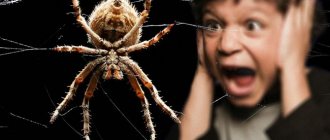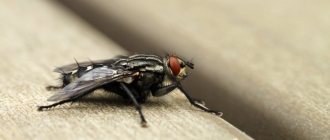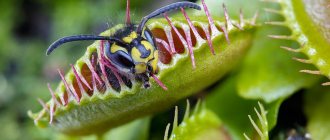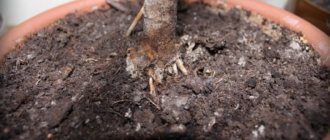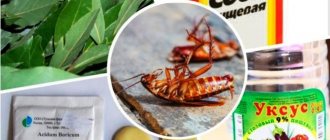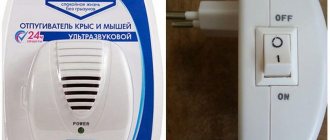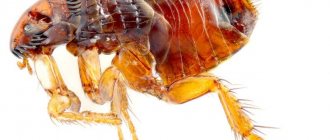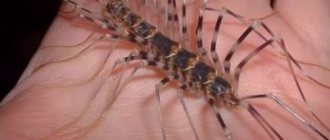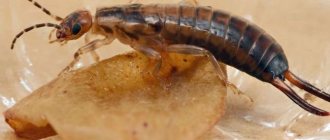Residents of private houses and owners of summer cottages with houses and outbuildings are familiar with two-tailed trees firsthand. These insects hide in corners, under tables, in sheds and domestic buildings. Such a neighborhood is extremely unpleasant, so it is customary to fight with two-tailed birds.
Dear readers! For you, we have created communities on social networks in which useful articles and interesting ideas are published several times a day! Subscribe and receive useful content in a convenient format!
This time we want to tell you how to get rid of double-easted insects in the most effective ways and what to do to prevent the appearance of a harmful insect on your territory.
What does a double tail look like, photo
The double-tailed bird (also known as an earwig) is an insect from the order Leatherwings, ranging from 7 to 50 mm in length. The double-tailed wing has 2 pairs of wings, but the upper one is shortened and is, rather, a rigid elytra, and the back one is membranous or absent altogether.
The insect got its name (two-tailed) for the characteristic pair of “claws” at the end of the body. The color is dark brown, brown, sometimes black. In the territory of the former USSR, the European earwig (mite) is mainly widespread.
The insect leads a nocturnal, secretive lifestyle. The main diet is organic remains of animal and plant origin, as well as small organisms.
Loves humidity, lives under stones in rotten leaves, as well as in secluded corners of human dwellings.
INTERESTING . There are forktails, which are vaguely similar to earwigs, but these insects represent different orders. Although in the scientific classification it is the forktails that are “real two-tails.”
Features of the life of earwigs
The insect loves warmth and moisture and often settles next to humans in rural areas. It is found in leaf litter, in compost heaps, under stones, fallen trees and near water bodies. Settles in residential buildings.
The insect is nocturnal - it hides in a shelter during the day, and crawls out at night in search of food. It is most active in cloudy, windy and rainy weather with minimal fluctuations in night and day air temperatures.
The pest reproduces in spring and early autumn . Mating lasts several hours. The male and female move back towards each other until their rear ends touch. After 2 months, the fertilized female lays white-yellow oval eggs in previously prepared burrows . She, alone or together with the male, makes a tunnel in the soil 5–15 cm deep with an expansion in the form of a chamber at the end.
It is there that the earwig lays 30–60 eggs in the fall and 20–30 in the spring. The female earwig is a caring mother; she remains near the eggs, rarely leaving the hole . Protects and turns eggs, providing the offspring with the most comfortable conditions. During this period, females are the most aggressive and bite the most painfully.
The earwig is an insect with an incomplete development cycle - from larvae it turns into an adult (imago) bypassing the pupal stage.
After spring mating, larvae appear 3 weeks later in May-June. They reach sexual maturity by the end of summer. During this time, the larvae molt 4 times. From eggs they emerge similar to adults, but smaller in size, gray-brown and without developed wings. With each molt, the insect's integument darkens and all parts of the body gradually form. Warm weather promotes rapid maturation of the insect.
During autumn fertilization, the eggs laid overwinter in the soil, and the adults crawl into burrows and hibernate.
The insect feeds variedly , eating living and rotting leaves and plant stems, the pulp of vegetables, fruits, bee bread and honey, pollen, lichens, and algae. From animal food it prefers the larvae of various insects, including pests: mites, aphids, caterpillars. Can eat bee larvae and the remains of large insects.
Are earwigs or double-tailed birds the same thing?
Not really. In the scientific classification, the doubletail is Diplura, also known as the forktail. A small insect of pale yellow or pale brown color. But in common parlance, the double-tailed earwig is called the earwig, Dermaptera. The insects are vaguely similar to each other, but still easily distinguishable.
It is earwigs that live in basements, crevices and old stumps. But since the name “two-tailed” has taken root among the people, we will use it precisely so as not to cause confusion. Moreover, when they say “two-tailed” they most often mean Dermaptera, the earwig.
INTERESTING. In different languages of the world, the name earwig means approximately the same thing: “pierce your ears,” “twist your ears.”
Interesting Quick Facts About Earwigs
- The second name of the earwig in Russian is two-tailed. Although the two-tailed insect is a completely different type of insect, which has neither direct nor indirect relation to earwigs.
- Earwigs are quite large creatures for the animal world. Their length can reach from 1 to 5 cm in length depending on age and species.
- Their bodies are dark brown, red-brown or black in color, adorned with a fine texture.
- The body is long, narrow, flattened with 3 pairs of legs. Most species have short, leathery forewings and thin hindwings, but the insects rarely fly.
- Earwigs are terrestrial animals that live primarily on the surface of the earth, although during the winter they can burrow a couple of tens of centimeters deep.
- The insect has a pair of antennae on its head, consisting of ten or more segments. Using sensors in their antennae, earwigs find food and respond to light.
- Due to the presence of “pincers” on the rear end of the body, earwigs began to be called two-tailed earwigs. They need this tool to simplify the capture of prey, and also serve as a weapon against predators.
- Females and males are easily distinguishable even by those who do not have special knowledge of entomology. Males tend to be darker, rougher and larger. The branches of their pliers are rounded.
- Earwigs get their name from the false belief that they often burrow into human ears and lay eggs inside the human brain. Although they can make their way into the outer ear canal, they prefer to stay away from there due to the lack of food and moisture in the ear canal.
- Earwigs are harmless to humans. They do not transmit diseases, and their bite, or rather pinching by ticks, does not contain poison.
- Insects are predominantly nocturnal. During the day, they sit in dark and damp places - inside hollow rotting trees, under stones, leaves, bark. They are very fond of cracks in the foundations of residential buildings, from where they crawl inward.
- Earwigs feed mainly on leaves, flowers, fruits, and moldy fungi. However, they are omnivores and can eat small insects, such as aphids, which provide invaluable support to gardeners. In addition, the insect is not very selective in the quality of its food; it can consume both fresh and dead rotting plant materials.
- Earwigs live in large groups. They secrete pheromones that help them find each other, so if one insect is found on the floor in the house, you need to look for a second one somewhere nearby.
- Earwigs also produce and release foul-smelling substances to ward off predators. This liquid contains no poisons.
- Natural enemies of earwigs include birds, insectivorous mammals, lizards, frogs, centipedes and spiders.
- The insect mating season occurs during the fall. Females store the male seed in their bodies until spring, when it is used to fertilize the eggs.
- The female lays 3 to 50 eggs, which hatch after 7 days. The larva (nymph) emerges from the egg and undergoes 4 to 6 molts before it finally reaches the size of an adult insect. The whole process takes 20-30 days, which is quite short for the insect world.
- Unlike other types of insects, females are able to take care of their offspring until the second or third molt. These are almost the only insects that know how to do this and do it.
- Earwigs can survive up to one year in the wild, which is also quite long compared to other insects.
How are they dangerous to humans?
Now let's talk about the harm earwigs cause to humans. Why are they dangerous to health and crops? And in general, is it worth fighting them or can you tolerate them like, for example, house spiders?
Let's start with the fact that earwigs look dangerous: an unpleasant brown color, a pair of claws on the abdomen. Such a neighborhood is clearly not a pleasant one.
Can it get into your ear?
Since childhood, many people know that the earwig crawls into the ear and pierces it. She then makes her way into the brain, where she raises her offspring. In fact, this is a common “urban legend”. The two-tailed fish, of course, can crawl into the ear and even bite a person tossing and turning in his sleep. But the likelihood of this is very, very small. With the same success, any insect can accidentally get into a person’s ear.
To summarize, we can say this: “An earwig can get into the ear, but only by accident.”
Do double tails spoil the harvest?
If the number of earwigs is not limited or these insects are not completely destroyed, then they can cause some damage to agriculture. In general, the earwig is more of a scavenger; it eats leaves, remains of animals, insects and plants. But in dry years, the insect turns its gaze to the fruits of fruit trees and berry bushes. It attacks apples, peaches, currants, cherries, etc.
The insect bites into the pulp of cracked and overripe fruits. It also leaves its excrement on fruits and berries.
The two-tailed insect can also attack vegetable crops. The leaves and fruits of beets, cucumbers, potatoes, tomatoes, etc. suffer.
IMPORTANT! Double-tailed insect causes damage to beekeeping. The insect makes its way into the hives, where it feeds on honey and beebread.
In the spring, earwigs are not averse to eating seedlings of tomatoes and peppers, as well as nibbling on indoor plants.
Do these insects bite?
The appendages at the end of the abdomen are used by the earwig for protection as well as for obtaining food. The two-tailed dog can bite with them if it senses danger emanating from you. The insect bites a person, but does it in self-defense.
In general, the insect is not poisonous, but since the earwig often feeds on carrion, it can spread the infection.
Often, after its bite, marks remain on the skin. An allergic reaction is possible: swelling, redness, itching. If you are hypersensitive to various allergens, be sure to take an antihistamine after a bite. If the consequences of the bite do not go away for too long, then consult a doctor.
How does the pincer reproduce and develop?
These insects bear offspring once every 12 months. They mate more often in September, then, if they live outside, they hide in holes. During the mating season, the male wags his tail, strokes and grabs the female, but does not hold him. If it receives the go-ahead, it connects with the female, turning its abdomen. This is how the “lady” moves and feeds.
Fertilization is internal, and in February - March the female lays a clutch of 30-55 eggs in a selected and equipped place. Protects, maintains cleanliness and humidity, and drives away the male.
After 2-2.5 months, small nymphs emerge. The earwig protects the young and feeds them regurgitated food until the 2nd moult has passed.
Sometimes the mother dies, then the babies, at first, feed on her body. Then at 2 months of age they go out to hunt. By autumn, insects are able to reproduce. The lifespan of earwigs is 12 months.
Why can double-tailed birds appear in the house?
Firstly, people themselves can accidentally bring two-east into the house along with vegetables, fruits, herbs, etc.
Secondly, two-tailed animals come on their own, since favorable conditions are created in the house for their growth and development.
For example, insects can crawl through cracks in floors from damp basements. Clogged vents are a great hiding place for earwigs. It is humid, warm and there is plenty of food.
If you don't take good care of your home, double tails will appear in places with high humidity. For example, in kitchens, bathrooms and utility rooms.
Two-tailed birds can also come into the house in search of food. Household waste and cleaning attract them with their smell. Insects can also enter the house with the harvested crops. Especially if you collect carrion of apples, pears, and apricots.
Description of the double tail
Double-tailed
Two-tailed animals are small arthropods from the order of cryptomaxillary hexapods. Their ancestors lived millions of years ago. Two-tailed birds live in tropical climates; out of 800 species, about 30 are found in Russia.
The body length of most species is 2–7 mm. It consists of a head capsule and an abdomen, divided into 11 segments. At the end of the abdomen there are 2 appendages (cerci). They can be long, thread-like or short, claw-like. Since two-tails do not have eyes, their functions are performed by the cerci.
The mouth is hidden in the head capsule. There are long antennae located in front of the head. On the initial segments of the abdomen there are 3 pairs of jointed limbs.
The body is bi-easted and light in color. Due to their inconspicuous coloring, small size and hidden lifestyle, they are hardly noticeable. They live in moist soil and humus, in damp fallen leaves. Life expectancy is about a year.
How to get rid of double east with folk remedies?
If there are not very many insects, or for some reason you do not want to use chemical insecticides, then you can try to remove two-easted insects using folk recipes.
Wet rags
This is the simplest trap. Place a wet rag in the box, make several holes and leave it overnight. In the morning, shake out the rag and kill the insects.
Onion and garlic solution
Grind a head of garlic and 1 onion. Mix, add 1 liter of water. Insist for a day. Then spray, treating the thresholds, doors, and crack corners. Frequency of treatments – 1 – 1.5 weeks.
Boric acid poison
Roll small balls from chicken yolk and a bag of boric acid. Place baits on the floors in places where insects accumulate, dark corners and damp rooms.
Herbal solution
For the infusion you will need any herbs that have a pungent odor. For example, yarrow, tansy, and wormwood are suitable. Pour a tablespoon of finely chopped herbs into a liter of boiling water. Let it sit for an hour and then spray the floors, corners, and walls in utility rooms.
Horseradish trap
Grate the horseradish, place it on trays and place it in corners and at the threshold. The pungent smell will scare away parasites.
Star
That same “star” repels insects with its pungent odor. The cream is applied to corners, walls, baseboards, and bed legs.
Sulfur checker
The checker can only be used in a private home. A prerequisite is the absence of people and animals in the house. Do not enter the premises for 48 hours after application.
Traditional methods
For various reasons, not everyone can afford to use toxic products from the chemical industry at home, so it is worth considering traditional methods of destroying and expelling two-worts from the house: Earwigs do not like strong odors, they scare them away and force them to leave their homes. People have long noticed this feature and developed methods of struggle.
- Onions and garlic are ground into a paste and diluted with boiling water, then the solution is left in a dark place for a day. It is necessary to treat all secret places where insects can hide with a “fragrant” product. After a week, the smell will disappear and the procedure must be repeated.
- An infusion of herbs with a strong odor will have the same effect; wormwood, oregano, and yarrow are suitable. A little more detergent or powder is diluted in it and also applied to joints, cracks, and baseboards. To ensure the quality of the result, repeat the treatment several times.
- “Bourne balls” are an attractive food for two-easts, but when they eat such a delicacy, they die very quickly. The secret is boric acid, although it is dangerous for any insects; they are attracted to the egg yolk mixed with it. The resulting pulp is rolled into balls, dried a little and laid out in places where their presence is likely. When preparing the composition, you should not forget about your own safety: you should wear rubber gloves on your hands.
- Another method of destroying two-easted birds, it is based on their love of dampness. Where they are supposed to live, you need to lay out crumpled wet rags or rags. After checking the trap after a while, you can find an insect hiding under it. You can destroy it by pouring boiling water over the fabric or by shaking the insect outside.
Aphids on roses: 7 effective methods to combat them
If a spider has settled in a secluded corner of the bathroom, you should not rush to destroy the web, it will help reduce the number of forktails, since you won’t mind feasting on them at all.
What drugs can be used against the pest?
To solve the problem quickly and permanently, you can use chemical insecticides. We have collected information about them in one table.
Table of drugs for dvostok
| Means | Application |
| Dichlorvos | Treat areas where insects gather with an aerosol. Repeat the treatment several times. Do not treat in rooms with children or pets. |
| Antibug | Treat baseboards, areas under cabinets, corners in damp areas and suspected pest areas. |
| Raptor | Carry out the treatment wearing personal protective equipment. Spray the aerosol on detected insects and in places where they are expected to accumulate. |
| Chalk "Mashenka" | Apply the product to the inside surfaces of tables, cabinets, and along baseboards. Pay special attention to possible places where insects accumulate. |
| Phenaxin | Sprinkle the powder in the areas where the parasite lives. Update the trap every 7 days. |
| Clean house | Spray the drug near the dwellings of the two-east. Carry out processing only in an empty room. |
| Karbofos | Dissolve the drug in water, mix thoroughly until smooth. Apply to surfaces near insect habitats with a paint brush. |
| Dust | Sprinkle the drug in corners and in rooms where double tails are most often found. |
| Tiuram | Sprinkle the powder onto pads and place it in corners, behind cabinets and in utility rooms. |
| a great warrior | The product is a poison in the form of a gel. Apply it in a dotted line to the substrates and place it along baseboards, in the kitchen, bathroom and utility rooms. |
| Aktellik | Suitable for outdoor use only. Spraying before harvest. |
| Tarax | 5 g per 1 liter of water. In the house, treat surfaces that insects come into contact with. Wet cleaning and ventilation are required. |
ON A NOTE. If you cannot get rid of uninvited guests on your own, then use the services of exterminators.
What is a double tail?
Double-tailed - this is how the insect was popularly called because of the strong chitinous outgrowths instead of a tail, called cerci. The correct term is earwig or forktail. It has an oblong segmented body of brown-red color with six legs. There are no eyes, and long antennae are located in front, reaching half of the insect's body.
It also has small wings, but the forktail rarely uses them and flies only short distances. Usually its size is modest: 2 or 3 cm, but there are also larger individuals that grow up to 7 cm. The cerci of all varieties are different: in medium-sized specimens they are small and relatively thin. The large ones have hard, powerful, claw-like claws, with which the two-tailed fish hunt springtails and small soil mites.
The doubletail settles in damp and cool places; it loves holes with humus. Two-tailed ducks are extremely agile and dexterous, move very quickly, hunt at night, not one at a time, but in flocks. Their diet is varied, the predator looks for larvae of small insects, microscopic mites and centipedes. He will not refuse the shoots and inflorescences of plants, fruits, vegetables, and will not disdain bread crumbs.
Penetrating into a living space, it hides in damp nooks, crevices between baseboards, boards, cracks in walls, and in the basements of houses. In apartments it hides in bathtubs and rooms with poor ventilation. Her presence in the house is not always immediately noticeable, because she goes out hunting at night and hides during the day.
How to get rid of it in a private house and country house
It is the hardest for summer residents to deal with earwigs. They visit their sites intermittently and cannot implement consistent measures to combat parasites.
The problem of double-easted insects is especially acute in the spring, when awakened insects begin to set up their homes.
But, at the same time, summer residents can use potent chemicals, sulfur bombs and odorous folk remedies (such as infusions of garlic and onions).
Also, owners of private houses with a personal plot or vegetable garden must definitely clean the area. Rotten leaves, old stumps, dry grass, rotten apples, pears and apricots - all this will certainly become a nesting site for two-easted birds. Therefore, you need to keep your area clean and tidy.
Grow wormwood, tansy, and then place these plants near the house. The smell is unbearable for insects, and they will prefer to find another place to live.
Reasons for appearing in the home
Double-tailed earwigs, or earwigs, are black insects with red-brown legs and heads, with a pair of sharp claws (a forked tail) at the end. The insects are also called claws because of their forked claws. They have an elongated flat body, reaching a length of one and a half to two centimeters.
In large numbers, two-tailed fish live in garden plots, making their burrows underground. In the vicinity of humans, they also settle in multi-apartment residential buildings (especially old housing stock and wooden ones). Insects make their home in foundation crevices, especially if basements are not dry enough.
Two-tailed moths feed on insect corpses and rotting plant debris. In search of food, they are able to travel long distances, often crawling into apartments and private houses through doors, windows, ventilation shafts, cracks, and crevices.
Earwigs come out to eat only in the dark, so often the owners of the home do not realize for a long time that they are being visited by unpleasant night guests. Two-tailed birds do not settle in the apartments themselves and do not lay eggs. However, if their colony is located in the neighborhood, they will crawl into the home often and in large numbers.
Measures to prevent the appearance
There are no special measures to prevent the appearance of biworts in the house. You just need to take care of your home. Clean regularly and do not allow moisture to accumulate or household waste and rubbish to be collected in remote areas of the house. Be sure to ventilate the room and warm the house or apartment well. It is also important to provide good ventilation that will not become clogged.
If the high level of humidity is due to factors beyond your control, then install moisture absorbers. The simplest method is bags of salt and crushed coal.
Also pay attention to food storage. Avoid rotting and molding. Keep jars tightly closed and food in refrigerators or designated containers.
Also regularly take out the trash and ensure that plumbing fixtures and household appliances are in good working order.
To get rid of uninvited guests in your garden, garden or personal plot, you also need a little. You just need to keep your plot in a well-groomed condition: remove branches, leaves and dry grass, do not leave carrion and rot on the lawn.
Preventive actions
To prevent a house or apartment from becoming attractive to pests, you need to perform simple prevention of their occurrence:
- promptly detect and repair sewer and water supply leaks;
- seal cracks in the foundation of a private house;
- seal window frames and doors;
- in the summer, install mosquito nets on open windows;
- use plastic containers for seedlings or thoroughly treat wooden ones with poisons before bringing them into the house;
- Disinfect the soil for indoor flowers and seedlings by steaming.
Common mistakes
Now let’s look at what mistakes summer residents most often make when fighting leatherbacks.
- Treatment of residential premises with strong chemicals. If you decide to get rid of double-east in a radical way, then be sure to take all precautions. Children and pets must not be present in the room during treatment.
- Ignoring the problem. Of course, you shouldn’t panic when you see one earwig. It is likely that she got into the house by accident. But, if insects begin to appear too often, then this is a reason to think about getting your house in order.
- Prevention is not carried out. Even if you use traps and crayons against two-wests, but do not take preventive measures, the fight will be in vain. New pests will take the place of dead pests, because your home has ideal living conditions for two-easters.
- Insect control is carried out incorrectly. All insecticidal agents only help to localize the problem. The main way to combat double-tailed insects is to keep your home clean and tidy.
Ways to fight
Dealing with insects is not difficult. The easiest way to deal with them is to set traps. Double-tailed animals are afraid of the smell of vinegar. For prevention, it is enough to periodically treat possible habitats of earwigs with a vinegar solution. They are also afraid of the smell of garlic, wormwood, tansy and laundry soap. Forktails can also be exterminated using chemicals. Insecticides are used for these purposes.
"Phosbecide"
A powerful Swiss insecticide used to exterminate a number of insects.
The drug can only be used to combat insects in nature. The product has class 2 toxicity. When treating premises with Fosbecid, there is a risk of human poisoning. The product does not evaporate well. The product is available in ampoules.
Before use, 1 ampoule is diluted with 0.5 liters of water. When fighting insects in nature, the solution is sprayed on the soil. This should be done in dry and windless weather. The best time to till the soil is morning or evening 20 days before harvest.
Advantages:
- quick effect;
- long period of validity.
Flaws:
harmful to bees and fish; cannot be used indoors; When working, precautions must be taken.
Review
| Elena Yu. |
| I bred forktails in a greenhouse. Everything worked out the first time. |
"Karbofos"
A powerful insecticide is effective in combating adult insects and their larvae, but is useless for destroying eggs laid by insects. The main component of the drug is malathion.
This is a very toxic substance that can cause human poisoning. The drug has been known since Soviet times and is available in the form of powder, liquid and aerosol. The volatility of the drug increases with increasing air temperature.
It is better to use aerosols for treating rooms. Work is carried out with windows and doors closed. You can enter rooms after treating them with karbofos only after thoroughly ventilating them.
Karbofos powder is poorly soluble in water. To dissolve it, use organic solvents or soap solutions. They are used to water insect-infested soil.
Advantages:
- high efficiency;
- affordable price;
- speed of action.
Flaw:
high degree of toxicity.
Review
| Igor K. |
| When I noticed a forktail in the house there was nothing at hand except karbofos. I treated the baseboards with it. This was enough to get rid of the unpleasant insects. |
"Tarax"
An effective drug with increased toxicity. Available in the form of a concentrate. Can be used to control cockroaches and other insects. When sprayed, the product forms a film that covers the surface to be treated. When insects fall on it, they die.
After treating the premises, you can enter them only after thorough ventilation and wet cleaning. Prepare a working solution from 200 ml of water and 1 g of substance. Spray it with a spray bottle only in those places where the two-tails are supposed to be located.
Advantages:
- fast action;
- high efficiency;
- availability.
The main disadvantage is the high degree of toxicity, which poses a danger to humans and animals.
Review
| Stepan G. |
| A strong remedy, but very poisonous. After treating the premises, it is impossible to enter them without ventilation. |
"Anti-bug"
The drug is intended to combat wood-boring beetles, but can also be used to combat double-tailed beetles. The product can be used indoors and outdoors.
Manufacturers produce the drug in the form of ready-to-use liquid and powder. The latter is used to bait insects in the form of a solution, which is applied to surfaces using a sprayer. Prepare a solution from the drug with water in a ratio of 1:4.
Advantages:
- versatility;
- efficiency;
- affordable price;
- environmental Safety.
Disadvantage: precautions must be taken when spraying the drug. Review. Review
Review
| Fedor Ch. |
| The drug is good, but does not cope with eggs laid by insects. You have to re-process it. |
"Raptor"
A universal product designed to combat various types of insects. Available in aerosol form. Acts as a barrier. After spraying, it creates a halo, under which insects die. Convenient for fighting insects living in hard-to-reach places (behind cabinets, under baseboards).
Advantages:
- versatility of use;
- convenient release form;
- efficiency;
- low cost.
Flaw:
the need to take precautions when spraying the drug. Review. Review
Review
| Valentin H. |
| I always keep the Raptor on hand at the dacha. It copes with double-tails “excellently”. |
Answers to frequently asked questions
Is the earwig poisonous?
No, but her claws may have an infection that causes skin irritation and an allergic reaction.
Is it true that an earwig crawls into the ear of a sleeping person?
On purpose - no. By chance, it can get there just like any other insect.
How to get rid of insects quickly?
Treat the room with an insecticide, clean, ventilate, remove debris and dirt.
Should earwigs be exterminated?
There is almost no benefit from these insects. Yes, they eat aphids, but they are more likely to cause damage to your garden. If you have an apiary, then you need to solve the double-east problem. They love to eat honey.
I don't want to kill insects. How to simply kick two-easters out of the house?
Then use non-lethal traps (for example, with a wet rag) and folk remedies that have a strong unpleasant odor. But you must understand that in this case you will have to constantly kick the two-easter out of the house.
Are there any benefits to earwigs?
As often happens in nature, it cannot be said that two-tailed insects are exclusively harmful insects. For example, these insects eat aphids, spider mites and other small pests.
However, one cannot say that this help is too noticeable. It is much easier to destroy both of these pests yourself, rather than breeding earwigs to eat aphids, and then fight with two-tailed insects.
Natural enemies
The two-easted bird has many enemies in nature. Birds readily peck at them - perhaps this is one of the reasons why these creatures are nocturnal. But danger awaits them in the soil too. Shrews and moles willingly feast on two-tailed fish and destroy their clutches.
These creatures are also destroyed by soil insects, for example mole crickets. The predatory larvae of many beetles also destroy two-easted beetles. But these creatures deftly avoid natural enemies, as they quickly move between particles of the earth thanks to three pairs of short but strong legs.
Two-tailed fish can exhibit cannibalism, eating small fellows of their own or other species. This is especially true for predatory representatives of the order.
